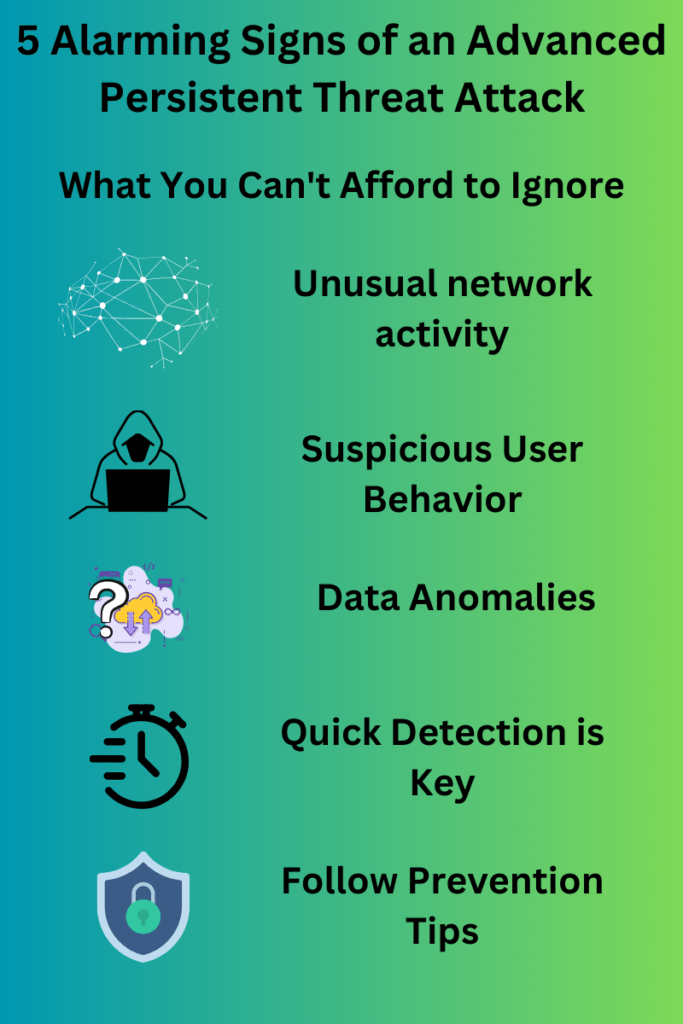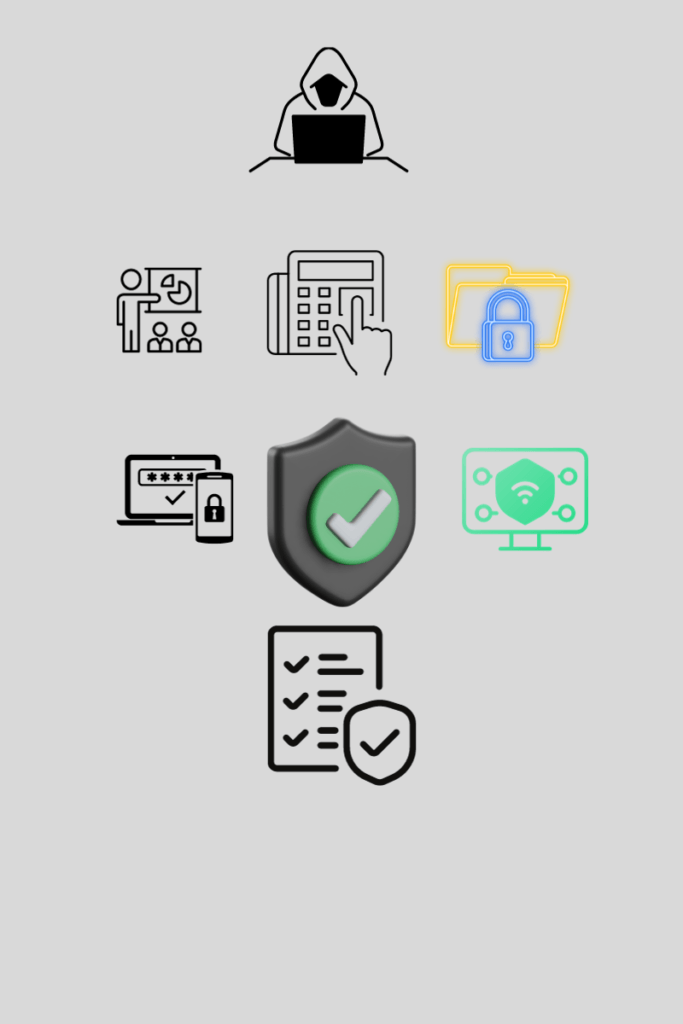Today, the threat of cyberattacks looms larger than ever. But not all cyber threats are created equal. Advanced Persistent Threats (APTs) are a unique breed of cyberattacks. They are stealthy, sophisticated, and potentially devastating. Recognizing the signs of an Advanced Persistent Threat attack is imperative.
In this guide, we’ll uncover the signs of an APT attack.
This post outlines the severity of APTs. It provides APT characteristics and the stages of attack. It emphasizes the importance of recognizing early signs. These signs, such as unusual network activity and suspicious user behavior, allow you to recognize the attack early.
Real-world APT incidents illustrate their potential damage.
Speed in identifying and responding to APTs is critical to minimizing their impact.

The Rising Threat Landscape: Why APTs are Different
Cyber threats are not just frequent but increasingly sophisticated. Because of this, understanding the nuances is crucial.
Ransomware and phishing attacks make headlines. However, APTs lurk in the shadows, often going unnoticed until it’s too late.
So, what sets APTs apart?
Other cyber threats aim for quick gains. On the other hand, APTs are long-term, highly strategic attacks. They’re orchestrated by skilled adversaries. They are often backed by substantial resources, be it criminal organizations or nation-states.
Their goal isn’t just immediate financial gain. Further, it often involves data exfiltration, espionage, or even sabotage.
Moreover, APTs are incredibly stealthy. They can infiltrate a network and remain undetected for months, or even years. They continuously evolve to bypass security measures. This makes them particularly dangerous for small businesses. These businesses may not have the resources for advanced cybersecurity measures.
In summary, while all cyber threats pose risks, APTs are in a league of their own. Their long-term nature, high-level backing, and stealthy tactics make them a unique and formidable threat. These threats requires specialized attention and action.
What Exactly is an Advanced Persistent Threat?
An Advanced Persistent Threat (APT) is a prolonged, targeted cyberattack. An intruder gains unauthorized access to a network and remains undetected for an extended period. Other cyber threats that are opportunistic. APTs are highly coordinated. They specifically target organizations for strategic objectives, such as data theft, espionage, or sabotage.
Unique Characteristics of APTs
- Prolonged Duration. APTs can last for months or even years, allowing attackers to dig deep into the network.
- Highly Targeted. These attacks are usually aimed at organizations or entities with high-value information.
- Resource-Backed. Often supported by well-funded organizations or nation-states.
- Stealthy Tactics. APTs use advanced techniques to remain undetected, often leveraging zero-day vulnerabilities.
- Multi-Stage Attacks. APTs don’t happen in one go; they’re a series of coordinated attacks.
How APTs Penetrate Your Defenses
Understanding how APTs breach security measures is crucial for fortification. MITRE has a model called ATT&CK (Adversarial Tactics, Techniques, and Common Knowledge) . This model serves as a comprehensive guide to the tactics and techniques employed by APTs.
Here are some ways APTs infiltrate.
Phishing Emails
Phishing is the prevalent tactic documented in the ATT&CK model. These emails often contain malicious attachments or links that install malware when opened.
Zero-Day Vulnerabilities
Zero-day vulnerabilities are unknown security flaws exploited by APTs to gain unauthorized access.
Social Engineering
Social engineering involves attackers posing as trusted individuals. They use this position to trick employees into revealing sensitive information.
Insider Threats
The threat can sometimes come from within, a tactic that the ATT&CK model also acknowledges. Disgruntled or malicious employees can facilitate APT attacks.
Supply Chain Attacks
Infiltration through third-party vendors or software updates is another tactic. A trusted component that gets compromised, can compromisie the entire network.
By integrating insights from the ATT&CK model, you can better understand the multifaceted tactics used by APTs. This will equip you to defend your organization more effectively.
Real-world Examples of APT Attacks
Understanding the theoretical aspects of APTs is crucial, but real-world examples can drive the point home. Here are two notable instances where APTs wreaked havoc:
1. Sony Pictures Entertainment (2014)
In 2014, Sony Pictures fell victim to an APT attack, allegedly orchestrated by North Korea. The attack led to the leak of unreleased films, confidential emails, and sensitive employee data. The motive was to prevent the release of a film that portrayed North Korea’s leader in a negative light. The resulting impact was financial losses estimated at $15 million in the initial months.
2. Operation Aurora (2010)
Google and several other companies were targeted in an APT attack originating from China. The aim was to gain access to intellectual property and sensitive data. The resulting impact was the theft of source code. User accounts were also compromised. There was also a significant hit to the companies’ reputations.
The Importance of Speed in Cybersecurity
In the realm of cybersecurity, time is of the essence. The longer an APT remains undetected, the more damage it can inflict. Here’s why speed is non-negotiable:
Early Detection Equals Less Damage
The sooner you detect an APT, the less time it has to move laterally across your network, minimizing potential damage.
Financial Implications
Every minute an APT goes undetected can cost your organization significantly, from data theft to reputational damage.
Regulatory Consequences
Quick action is often mandated by data protection laws. Failure to act swiftly can result in hefty fines and legal repercussions.
Containment and Eradication
Rapid detection enables quicker containment of the threat, preventing it from spreading to other parts of the network.
Competitive Advantage
In a market where trust is paramount, being known for robust and speedy cybersecurity can set you apart from competitors.
Understanding the critical role of speed in cybersecurity can be the difference between a manageable incident and a full-blown catastrophe.
Final Thoughts: Recognizing the Signs of an Advanced Persistent Threat Attack
Advanced Persistent Threats (APTs) stand out for their complexity and potential for severe damage. Recognizing the signs of an APT attack is crucial for timely intervention.
The ATT&CK model serves as a comprehensive guide for understanding the tactics and techniques employed by APTs. It emphasizes the importance of speed in detection and response. Early detection not only minimizes damage but also has financial and regulatory implications.
Vigilance and quick action are your best defenses against the insidious and highly damaging nature of APTs.
Questions? We Have Answers.
Get answers to a list of the most Frequently Asked Questions.
A: [6].

Experienced cybersecurity analyst, software engineer, patent attorney, worked with Linux, Windows, AWS, lots of security tools. Hope to help people do the right things and do the things right!


